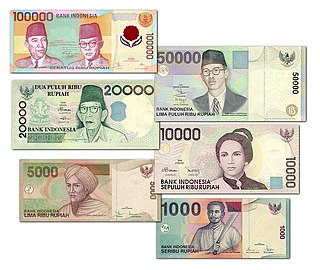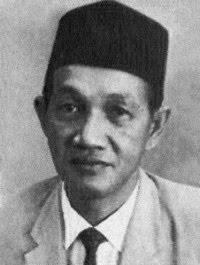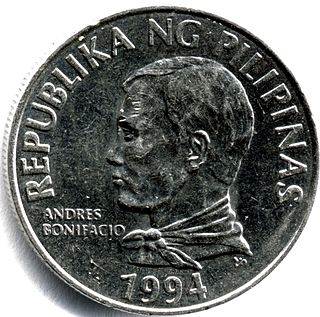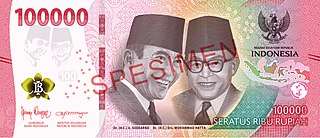
The guinea was a coin, minted in Great Britain between 1663 and 1814, that contained approximately one-quarter of an ounce of gold. The name came from the Guinea region in West Africa, from where much of the gold used to make the coins was sourced. It was the first English machine-struck gold coin, originally representing a value of 20 shillings in sterling specie, equal to one pound, but rises in the price of gold relative to silver caused the value of the guinea to increase, at times to as high as thirty shillings. From 1717 to 1816, its value was officially fixed at twenty-one shillings.

The rupiah is the official currency of Indonesia, issued and controlled by Bank Indonesia. Its name is derived from the Sanskrit word for silver, rupyakam (रूप्यकम्). Sometimes, Indonesians also informally use the word perak in referring to rupiah in coins. The rupiah is divided into 100 cents, although high inflation has rendered all coins and banknotes denominated in cents obsolete.

The national emblem of Indonesia is called Garuda Pancasila. The main part is the Garuda with a heraldic shield on its chest and a scroll gripped by its legs. The shield's five emblems represent Pancasila, the five principles of Indonesia's national ideology. The Garuda claws gripping a white ribbon scroll inscribed with the national motto Bhinneka Tunggal Ika written in black text, which can be loosely translated as "Unity in Diversity". Garuda Pancasila was designed by Sultan Hamid II from Pontianak, supervised by Sukarno, and was adopted as the national emblem on 11 February 1950.
The One guilder coin was a coin struck in the Kingdom of the Netherlands between 1818 and 2001. It remained in circulation until 2002 when the guilder currency was replaced by the euro. No guilder coins were minted in the German occupation of the Netherlands in World War II.
The ten-cent coin is the lowest-denomination circulating coin of the Hong Kong dollar. With a diameter of 17.5 millimetres (0.69 in) and a mass of 1.85 grams (0.065 oz) it is also the smallest in size and weight. It is the oldest coin denomination to still be in circulation in Hong Kong. Since its first issue in 1863, there has only been one period (1942–1947) where the coin was not in use.

The first coins of the Indonesian rupiah were issued in 1951 and 1952, a year or so later than the first Indonesian rupiah banknotes printed, following the peace treaty with the Netherlands in November 1949. Although revolutionary currency had been issued by the provisional Indonesian government between 1945 and 1949, it had all been formed of paper, for metal were too scarce for the internationally isolated government to use as currency.

The first banknotes used in the archipelago that would become Indonesia were those issued by the United East India Company, credit letters of the rijksdaalder dating between 1783 and 1811. Netherlands Indies gulden government credit paper followed in 1815, and from 1827 to 1842 and again from 1866 to 1948 gulden notes of De Javasche Bank. Lower denominations were issued by the government in 1919–1920 and in 1939–1940 due to wartime metal shortages, but otherwise day-to-day transactions were conducted using coinage.
Orzeł bielik gold coins are a series of gold bullion coins of .9999 purity, issued by the Polish National Bank. These coins were minted on the order of the President of the Polish National Bank on 12 June 1995.

The krone coin is the second-smallest denomination of the Danish krone.

Idham Chalid was an Indonesian politician, religious leader, and minister, who served as Chairman of the People's Consultative Assembly and Chairman of the People's Representative Council from 1972 until 1977. He was also a prominent leader of the Nahdlatul Ulama (NU) and leader of the United Development Party (PPP), from 1956 until 1984.

I Gusti Ketut Pudja was an Indonesian politician and national hero, who served as the first governor of Lesser Sunda from 1945 until 1946. He was a member of the Investigating Agency for Preparatory Work for Indonesian Independence (BPUPK). He was also present at Admiral Tadashi Maeda's house, during the preparation for the Proclamation of Indonesian Independence on 17 August 1945. Making him the only Balinese to be present during the proclamation.

The Indian 10-rupee coin is a denomination of the Indian rupee. The ₹10 coin is the second highest-denomination coin minted in India since its introduction in 2005. The present ₹10 coin in circulation is from the 2019 design. However, the previous ₹10 coins minted before 2019 are also legal tender in India. All ₹10 coins containing with and without the rupee currency sign are legal tender, as stated by the Reserve Bank of India. Along with the standard designs, there are 4 different designs for this denomination and this is used alongside the 10 rupee banknote.

The Philippine two-peso coin (₱2) was a denomination of Philippine currency. It was minted by the Bangko Sentral ng Pilipinas from 1983 to 1994 and was demonetized in 1998.

The Indonesian one thousand rupiah coin (Rp1,000) is a coin of the Indonesian rupiah. It circulates alongside the 1,000-rupiah banknote. First introduced on 8 March 1993 as bimetallic coins, they are now minted as unimetallic coins, with the first of its kind appearing in 2010 and its latest revision being in 2016. As of 2024, the last two series in this denomination are legal tender.

The Indonesian two thousand rupiah banknote (Rp2,000) is a denomination of the Indonesian rupiah. First introduced on July 9, 2009, it was made legal tender the following day and has since been modified two times, first in 2016 and then in 2022. All notes of this denomination are printed in cotton paper since its inception.

The fifty rupiah coin (Rp50) is a denomination of the Indonesian rupiah. It was first introduced in 1971 and last minted in 2003. As of 2020, only aluminum Rp50 coins dating from 1999 through 2003 remain legal tender, although it is rarely seen in circulation due to its extremely low value.

The Indonesian twenty five rupiah coin (Rp25) is a now-defunct denomination of the Indonesian rupiah. It was introduced in 1971 and was last revised in 1991. Coins of this denomination were minted until 1996 and have been invalid for transactions since August 31, 2010 when the 1991-issue Rp25 coin ceased to be legal tender.

The Indonesian five hundred rupiah coin (Rp500) is a denomination of the Indonesian rupiah. It was introduced in 1991 and has since been revised three times in 1997, 2003, and 2016. It currently has the second-highest value of all circulating rupiah coins after the Rp1,000 coin. As of December 2023, only alumunium 500 rupiah coins, dated 2003 and 2016, are legal tender.

The Indonesian one hundred rupiah coin (Rp100) is a denomination of the Indonesian rupiah. First introduced in 1973 in cupronickel, it has been revised four times throughout its history, changing materials in 1991 and 1999. As of 2022, it is the second-lowest valued coin of the rupiah after the now-rarely encountered Rp50 coin.

The Indonesian one hundred thousand rupiah banknote (Rp100,000) is a denomination of the Indonesian rupiah. Being the highest and second-newest denomination of the rupiah, it was first introduced on November 1, 1999, as a polymer banknote before switching to cotton paper in 2004; all notes have been printed using the latter ever since.



















